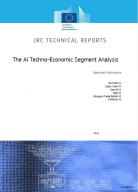Description
The Techno-Economics Segment (TES) analytical approach aims to offer a timely representation of an integrated and very dynamic technological domain not captured by official statistics or standard classifications. Domains of that type, such as photonics and artificial intelligence (AI), are rapidly evolving and expected to play a key role in the digital transformation, enabling further developments. They are therefore policy relevant and it is important to have available a methodology and tools suitable to map their geographic presence, technological development, economic impact, and overall evolution.
The TES approach was developed by the JRC. It provides quantitative analyses in a micro-based perspective.AI has become an area of strategic importance with potential to be a key driver of economic development. The Commission announced in April 2018 a European strategy on AI in its communication "Artificial Intelligence for Europe", COM(2018)237, and in December a Coordinated Action Plan, COM(2018)795. In order to provide quantitative evidences for monitoring AI technologies in the worldwide economies, the TES approach is applied to AI in the present study.
The general aim of this work is to provide an analysis of the AI techno-economic complex system, addressing the following three fundamental research questions: (i) Which are the economic players involved in the research and development as well as in the production and commercialisation of AI goods and services? And where are they located? (ii) Which specific technological areas (under the large umbrella of AI) have these players been working at? (iii) How is the network resulting from their collaboration shaped and what collaborations have they been developing?
This report addresses these research questions throughout its different sections, providing both an overview of the AI landscape and a deep understanding of the structure of the socio-economic system, offering useful insights for possible policy initiatives. This is even more relevant and challenging as the considered technologies are consolidating and introducing deep changes in the economy and the society. From this perspective, the goal of this report is to draw a detailed map of the considered ecosystem, and to analyse it in a multidimensional way, while keeping the policy perspective in mind.
The period considered in our analysis covers from 2009 to 2018. We detected close to 58,000 relevant documents and, identified 34,000 players worldwide involved in AI-related economic processes. We collected and processed information regarding these players to set up a basis from which the exploration of the ecosystem can take multiple directions depending on the targeted objective. In this report, we present indicators regarding three dimensions of analysis: (i) the worldwide landscape overview, (ii) the involvement of players in specific AI technological sub-domains, and (iii) the activities and the collaborations in AI R&D processes. These are just some of the dimensions that can be investigated with the TES approach. We are currently including and analysing additional ones.

